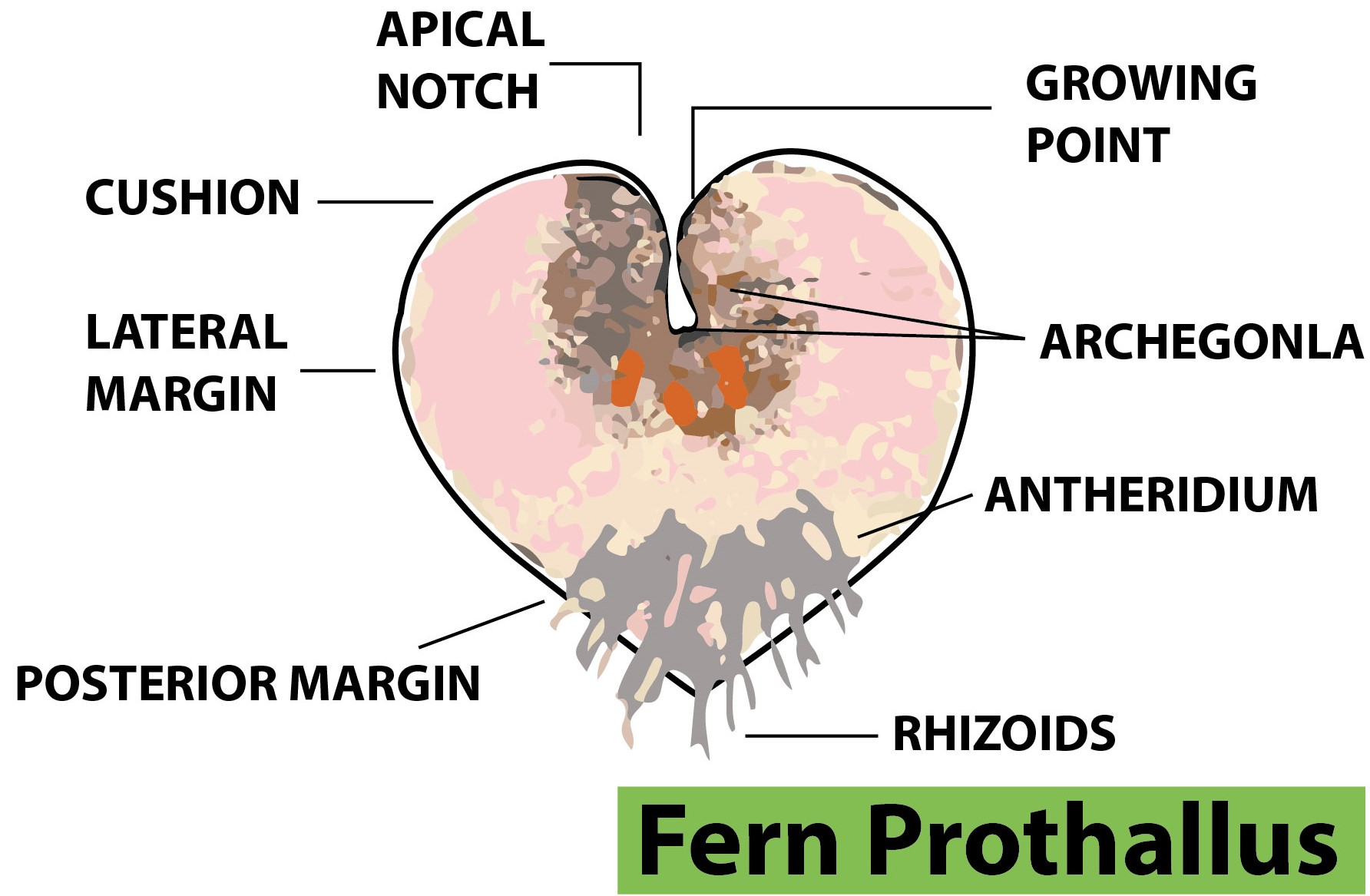
In Pteridophytes, the spore germinates to form
(a)Protonema
(b)Prothallus
(c)Sporophyte
(d)Archegonium
Answer
468.6k+ views
Hint: Pteridophytes are vascular plants that disperse spores and neither produces flowers nor seeds. They do not show reproduction, which means the reproduction is hidden in Pteridophytes. They are closely related to seed plants. They have alternating free-living gametophyte and Sporophyte phases.
Complete answer:
The spores germinate to form prothallus in pteridophytes. Prothallus is the gametophyte stage in the life of a fern. It is used to describe the gametophyte of a liverwort or peat moss as well. It develops from a germinating spore and is a short-lived heart-shaped structure typically 2 to 5 millimeters wide which contains several rhizoids that grow underneath. The ferns are fully grown sporophyte which produces genetically unique spores in the sori by the process of meiosis. The prothallus developed and grows sex organs that produce archegonia and flagellated sperm antheridia. The sperm float to the ova for fertilization and produce a diploid zygote which divides by mitosis to form multicellular sporophyte.
Additional Information: Protonema: A Protonema is a chain of cells that form the earliest age of the mosses that are haploid. They germinate to form filamentous algae like structure which is known as the Protonema. It grows by apical cell division. It is composed of two cell types: chloronema and caulonema. At some stage, it gets influenced by the phytohormone cytokinin in which the buds are induced which grow by three-phase apical cells.
Sporophyte: Sporophyte is the diploid stage in the life cycle of a plant or algae. It gets developed from the zygote which is produced when a haploid egg cell is fertilized by a haploid sperm and an eating sporophyte cell has a double set of the chromosome from each parent. The multicellular diploid sporophyte phase gets alternate with the multicellular Haploid gametophyte phase. Spores are produced by the sporophyte by the process of meiosis which is known as the reductional division. It reduces the number of chromosomes in each spore mother cell which gets developed into a gametophyte.
Archegonium: It is the multicellular structure organ of a gametophyte that contains or produces the female gamete known as the ovum. The male gamete corresponding to it is known as the antheridium.
So, the correct answer is 'Prothallus'.

Note: There are 10,560 species of fern and some of them are the oldest plants in the world. They appear in the Fossil record for about 360 million years ago. They are beneficial to humans for restoring the contaminated soil and can range up to a height of 66 feet or 20 meters.
Complete answer:
The spores germinate to form prothallus in pteridophytes. Prothallus is the gametophyte stage in the life of a fern. It is used to describe the gametophyte of a liverwort or peat moss as well. It develops from a germinating spore and is a short-lived heart-shaped structure typically 2 to 5 millimeters wide which contains several rhizoids that grow underneath. The ferns are fully grown sporophyte which produces genetically unique spores in the sori by the process of meiosis. The prothallus developed and grows sex organs that produce archegonia and flagellated sperm antheridia. The sperm float to the ova for fertilization and produce a diploid zygote which divides by mitosis to form multicellular sporophyte.
Additional Information: Protonema: A Protonema is a chain of cells that form the earliest age of the mosses that are haploid. They germinate to form filamentous algae like structure which is known as the Protonema. It grows by apical cell division. It is composed of two cell types: chloronema and caulonema. At some stage, it gets influenced by the phytohormone cytokinin in which the buds are induced which grow by three-phase apical cells.
Sporophyte: Sporophyte is the diploid stage in the life cycle of a plant or algae. It gets developed from the zygote which is produced when a haploid egg cell is fertilized by a haploid sperm and an eating sporophyte cell has a double set of the chromosome from each parent. The multicellular diploid sporophyte phase gets alternate with the multicellular Haploid gametophyte phase. Spores are produced by the sporophyte by the process of meiosis which is known as the reductional division. It reduces the number of chromosomes in each spore mother cell which gets developed into a gametophyte.
Archegonium: It is the multicellular structure organ of a gametophyte that contains or produces the female gamete known as the ovum. The male gamete corresponding to it is known as the antheridium.
So, the correct answer is 'Prothallus'.

Note: There are 10,560 species of fern and some of them are the oldest plants in the world. They appear in the Fossil record for about 360 million years ago. They are beneficial to humans for restoring the contaminated soil and can range up to a height of 66 feet or 20 meters.
Recently Updated Pages
How do you factor x2 + x 20 0 class 9 maths CBSE

How do you solve y6x and 2x+3y20 using substitutio class 9 maths CBSE

Chipko movement originated in Gopeshwar in A 1953 B class 9 biology CBSE

The adjacent sides in the parallelogram are supplementary class 9 maths CBSE

The compound used in plastic industry is A Vinyl acetate class 9 chemistry CBSE

How do you solve for y in 2left y dfrac12 right 4left class 9 maths CBSE

Trending doubts
According to Bernoullis equation the expression which class 11 physics CBSE

Draw a diagram of nephron and explain its structur class 11 biology CBSE

Differentiate between calcination and roasting class 11 chemistry CBSE

A solution of a substance X is used for white washing class 11 chemistry CBSE

What is spore formation class 11 biology CBSE

10 examples of friction in our daily life




